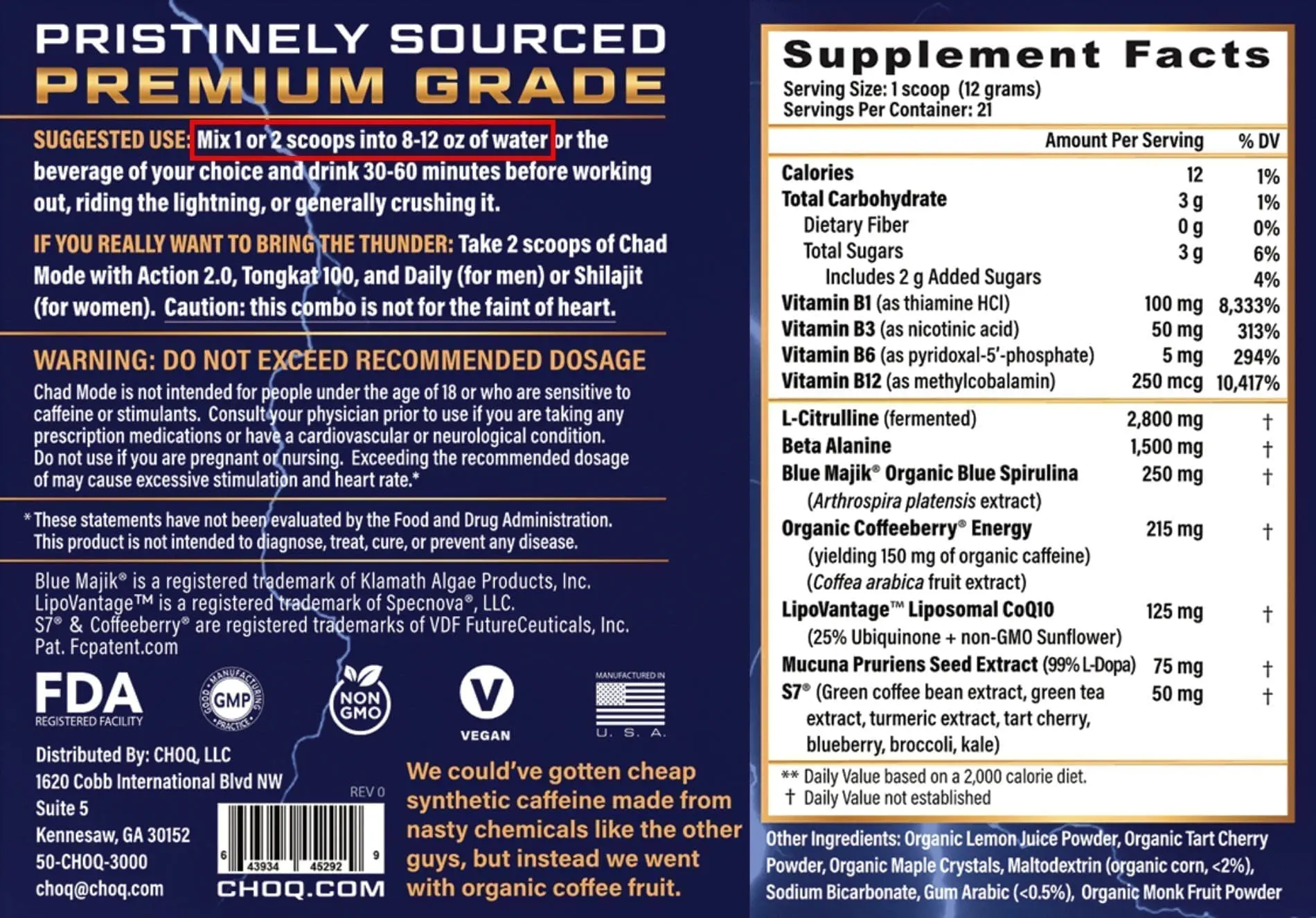Recently, an aspiring fitness influencer by the name of Jackson Hooper posted an extremely negative review of Chad Mode on TikTok.
In his video, Hooper makes a series of statements that are not only factually incorrect, but would be considered ridiculous to anyone with even a sliver of training in nutritional science.
Hopefully, this rebuttal will serve as a warning to Mr. Hooper and all the other gym bros with zero scientific training: don’t make falsifiable statements about things that you know very little about unless you’re prepared to look quite foolish.
In other words: don’t bring a knife to an intellectual gunfight.
Hooper misunderstands Chad Mode dosing options and ignores top selling point
Before we go into all the details, it’s critical to mention that some of Hooper’s criticisms center around the doses being too low.
It’s clear that he believes that Chad Mode is a single scoop formula from his video. Most likely, he only looked at the supplement facts panel, which shows the amounts for one scoop. The directions on the label, as well as the product page, both designate that Chad Mode is a multi-dose formula that can be taken at one or two scoops.
A LOT of thought went into the doses used in Chad Mode. The doses on the SF panel are not arbitrary by any means. Chad Mode is made for everyone, from the smallest woman to the largest professional athlete.
That being said, the science is still in favor of clinical effects even at 1 scoop.
In addition, he ignores the top selling point of Chad Mode: that it’s 100% free of the chemical dyes, flavors, preservatives, and sweeteners that 99% of pre-workouts contain.
If you’re someone who’s perfectly okay with chemicals like red #40, sucralose, artificial flavors, and all the other junk that’s ruining our health, then Chad Mode probably isn’t for you.
Chad Mode is for those who want an ultra-clean alternative to the chemical-laden junk out there. In other words, it’s for folks who care enough about what they put in their bodies that they prefer organic blue spirulina over a chemical like Xylene Blue VSG (AKA ‘Blue #1’).
Before we get started, here’s a picture of the label for reference:

Claim #1 – The B vitamins are too high
In the beginning of the video, Mr. Hooper said:
“First off, you have an insane amount of vitamin B. No one needs 8,000% of their vitamin B1 intake or 10,000% for their vitamin B12 intake.”
This is a commonly used fallacy among novices in the nutrition world: that doses that exceed the recommended daily intake are automatically dangerous and inappropriate.
Hooper’s accidentally showing his hand here, as absolutely nobody who understands the first thing about B vitamin supplementation would make such a ridiculous statement.
His criticism misses the point entirely.
With all vitamins, there are doses that prevent blatant deficiency–extreme depletions which result in severe, often life-threatening diseases (e.g. Berberi in the case of B1 deficiency)–and then there are doses that can produce specific beneficial effects in the body. When researchers set out to determine whether a vitamin can achieve a certain physiological outcome, they know full well that they’re not merely giving people enough to prevent deficiency.
All of the doses of B vitamins in Chad Mode are both reasonable and quite common among supplements.
Hooper clearly outside his wheelhouse: B12 pharmacokinetics for dummies
Hooper clearly lacks either the ability to understand research or the willingness to spend time doing it.
For those who do read papers in nutrition, however, it’s well known that B12 has notoriously low bioavailability, and thus 98-99% of all supplemental B12 is never absorbed.
Vitamin B12 therefore has to be dosed in extremely large quantities to have beneficial effects. In fact, 250 mcg (the amount in one scoop of Chad Mode) is considered a fairly conservative dose.
In this paper–written by faculty at the department of pharmacology at Oxford–the authors share the following table on B12 bioavailability:
(screenshot from nutritionfacts.org B12 literature review)
As you can see, a dose of 500 mcg per day only ends up supplying the body with 9.7 mcg (about 2%).
The researchers go on to say:
“We recommend that an oral dose of 500 micrograms per day should be the minimum used to treat those with B12 in the low-normal range.”
Note how they’re not even referring to outright deficiency, but rather blood levels of B12 in the suboptimal range. 500 mcg is the exact dose that’s in 2 scoops of Chad Mode. Vitamin B12 also has no officially recognized Tolerable Upper Intake Level, meaning that it’s considered unlikely to cause harm at any dose.
This article would be far too long if we went into detail on all of the B vitamins in Chad Mode.
There are countless studies that demonstrate their safety and efficacy at doses near or above the amounts in Chad Mode.
If you’d like to learn more, here are some links to these nutrients’ respective pages on the Linus Pauling Institute website (each page contains a large number of scientific references):
Claim #2 – There’s not enough Citrulline
As mentioned, Hooper was under the mistaken impression that Chad Mode is a one scoop formula because the supplement facts panel only lists the doses at one scoop.
Even if Chad Mode were a single scoop formula though, his statements are still wrong.
Hooper said:
“And you might as well not even have L-Citrulline in here because it’s not at a clinical dosage.”
During this part of the video, he flashes a screenshot of this study that says the minimum effective dose is 3 grams per day.
Chad Mode supplies 2,800 mg of citrulline in one scoop and 5,600 mg in two scoops. So, what’s the problem exactly?
A 2019 meta-analysis reviewed twelve high quality clinical studies, each using anywhere from 3.3 grams to 6 grams of citrulline, with some studies using either 6 or 12 grams of citrulline malate.
These studies did not specify the ratios of the citrulline malate, but assuming they were 2:1 and not 1:1, that means that those studies were using either 4 grams or 8 grams of citrulline (with the remainder being malic acid).
The authors concluded that citrulline is effective in these dose ranges.
The difference between 2,800 and 3,000 mg is only about 6%, but a person who only weighs 120 lbs (which includes many women) is over 30% smaller than the male athletes that are commonly the subjects of these studies, and thus the mg / kg dose effectively pushes them into a relatively much higher dose.
Like we said, Chad Mode was formulated with a great deal of care and is made for everyone. A two-scoop serving will of course be preferable for larger and more experienced users.
Claim #3 – There’s not enough Beta-Alanine
Hooper states:
“…and then the same with beta-alanine. That’s well underdosed. And if you say, ‘well, I don’t really care about the performance aspect. I just like the tingles,” you’re not really gonna feel it on 1,500 milligrams.”
Yes sir, that’s precisely the point. We purposely gave the user the ability to take one scoop in order to avoid these sensations, or to take two, in order to get the full effects.
Smaller, more sensitive people sometimes still experience the beta-alanine tingles from only 1,500 milligrams. For people who are not used to it, this can be a huge turn-off.
It’s quite possible that had Hooper noticed that Chad Mode can be dosed at 1 or 2 scoops, he may not have made this criticism, so it may not be all that helpful to spend too much time on this one.
That being said, it’s also not true to claim that there are no documented effects below 3,200 milligrams, which he indicated with the screenshot he shared.
For example, in this study, the authors gave 1,500 mg of beta-alanine to women for 6 weeks and found that it significantly increased their exercise tolerance. Again, Chad Mode is for everyone, including women.
Two scoops of Chad Mode, which will be the preferred dose for most athletes, provides 3 grams. The difference between 3.2 grams, which is considered an effective dose—and 3 grams is negligible (also only 6%).
Here is a link to a meta-analysis on beta-alanine if you’d like to review the data for yourself.
Claim #4 – B Vitamins in Chad Mode probably come from Blue Majik®
Hooper said:
“Then, next up, you have this experimental ingredient called ‘Blue Majik’, which is where all the vitamin B is probably coming from.”
When you become a professional in a certain field, it’s fairly easy to tell when you’re dealing with someone with zero expertise based on the kinds of statements they make.
For example, let’s say you’re a certified car mechanic. You meet someone at a party who claims to be great with cars, but then immediately admits to not knowing what a fuel injector is.
The fact is that no plant or animal on planet Earth could ever supply these levels of B vitamins…not even close.
Further, he does not understand how to read supplement labels. If you look at a vitamin and see a hard-to-pronounce molecular name in parenthesis next to it–for example “Vitamin B6 (as pyridoxal-5’-phosphate)–that means that it’s coming from a pure vitamin and not from a plant.
Still, he could have at least attempted to look up the quantities of B vitamins in blue spirulina before he made this comment, something that would have taken only a few minutes.
The Blue Majik® organic blue spirulina in Chad Mode gives it a brilliant blue color, BUT–unlike the chemical dyes that gym bros like Hooper seem to have no problem with–is not only non-toxic, but also contains beneficial phytochemicals.
From a formulation standpoint, using a natural ingredient to both impart a beautiful color and enhance the health benefits is ingenious.
For the sake of brevity, we’ll just say here that the phycocyanins in Blue Majik are potent antioxidant that can promote healthy inflammation response. Still, the primary purpose of this ingredient–to naturally impart color without the use of toxic chemicals–was ignored
A quick note on caffeine dosing & safety
Mr. Hooper referred to the caffeine levels in Chad Mode as ‘low stim’, but we can be certain that this is only because he incorrectly assumed it was a single scoop product.
Each scoop contains 150 mg of caffeine from Organic Arabica coffee fruit (not the ammonia-derived synthetic junk from China everyone else uses). If you try a full 2 scoops of Chad Mode, with 300 mg of caffeine, ‘low stim’ will absolutely NOT be a phrase that comes to mind.
Caffeine safety is essential. Panera Bread is now being sued because a woman with a heart condition died after drinking their ‘Charged Lemonade’, which contained 390 mg per serving.
400 mg is considered the safe recommended daily intake by the FDA, and thus we think that 300 mg is the ideal dose in 2 scoops, as it still allows you to have another caffeinated beverage without worrying about massively exceeding the recommended daily intake.
Claim #5 – CoQ10 is an ‘experimental’ ingredient with insufficient research behind it
Hooper says:
“Then you have liposomal CoQ10. I’m not going to lie. This one seems very experimental. There’s not really any good research on it for exercise performance.”
If by ‘experimental’, he means that quite a few experiments have shown its benefits to human health, then Hooper’s correct.
At the risk of beating a dead horse here, this is yet another alarm bell that indicates his unfamiliarity with supplements and nutritional biochemistry.
Hooper fails to mention that CoQ10:
- Has been shown to reduce exercise-induced muscular injury in athletes, as evidenced by reductions in creatine kinase (CK), a marker of muscle damage.
- Was shown to reduce exercise-induced cardiovascular damage and oxidative stress in this study
- Can reduce fatigue during exercise
Without CoQ10, your cells cannot produce energy. If your levels fell to zero, you would die immediately. That’s how crucial this molecule is.
CoQ10 is in especially high demand by tissues like the brain, liver, heart, and especially skeletal muscles. Its stellar reputation as an incredible cardiovascular supplement is due to its ability to promote ATP production.
Good formulators include ingredients for a variety of reasons. Formulas have multiple purposes, and it’s fallacious to claim that just because an ingredient does not have tons of research for the primary purpose of the product, that it should not be included.
Based on the biochemistry, there is ample reason to believe that the ultra high absorption liposomal CoQ10 in Chad Mode should assist with ATP production and overall energy levels, but its role as an antioxidant that can prevent exercise-induced tissue damage make it a no-brainer.
Further, we are in communication with a company that is currently researching their CoQ10 for athletic performance, and will update this article when they complete their studies.
Claim #6 – Not enough L-DOPA
Hooper says:
“I’m not even a fan of L-DOPA but if you’re gonna put it in, at least put it in at a clinical dosage. Once again, it’s underdosed for no reason.”
Aside from the aforementioned error that Hooper makes regarding Chad Mode’s two dosing options, he makes yet another rookie mistake here.
The screenshot he used to demonstrate clinically effective dosing of L-DOPA is from a Mayo Clinic article that’s referring to its use as a prescription drug to treat Parkinson’s disease. This has absolutely nothing to do with its use as a plant-derived supplement to support mood and focus in healthy individuals.
A full two-scoop dose of Chad Mode contains 148 mg of L-DOPA from Mucuna pruriens, which we believe is an appropriate dose to subtly support dopamine levels. If you look at Mucuna products, you will find that virtually none of them contain more than 150 mg of L-DOPA. There’s a good reason for this.
We consider quantities in excess of 300 mg per day to be excessive, especially if taken every day. This is not a supplement where more is always better. You tend to get diminishing returns when you increase the dose.
Additionally, many popular nootropics contain L-DOPA, and we also want people to be able to take Chad Mode if they’re already taking one of these products.
Will you change your ways, Mr. Hooper?
We assume, Mr. Hooper, that you’re reviewing these pre-workout products in good faith and have made some major errors due to misunderstanding the dosing.
We would love if you used this opportunity to correct the mistakes you’ve made in your initial analyis of Chad Mode.
If you truly value empirical knowledge and want to give your viewers the best possible information, then we look forward to another video that makes accurate, evidence-based claims about our product.
Chad Mode is the cream of the crop
Not only are the ingredients in Chad Mode impeccably dosed, but they’re some of the highest quality you’ll see in any pre-workout.
As mentioned before, if you don’t care about artificial dyes, flavors, preservatives, and flavors, then we suggest you stick to the cheap trash on Amazon.
If, however, you’re looking for an ultra-clean product that uses organic spirulina for color instead of Blue #1, organic coffee fruit instead of ammonia-based synthetic caffeine from China, and actual organic fruit powders instead of the mystery chemicals in artificial flavors, then Chad Mode is your absolute best option.
We even went out of our way to avoid the so-called ‘natural flavors’ that are in many cases just as problematic as the artificial ones, and not remotely natural by any reasonable definition of the word (check out this article to learn more about why they’re bad news).
If you’d like more in-depth information on Chad Mode, then we recommend this information page, which goes into detail on every aspect of the formula, including each ingredient.




